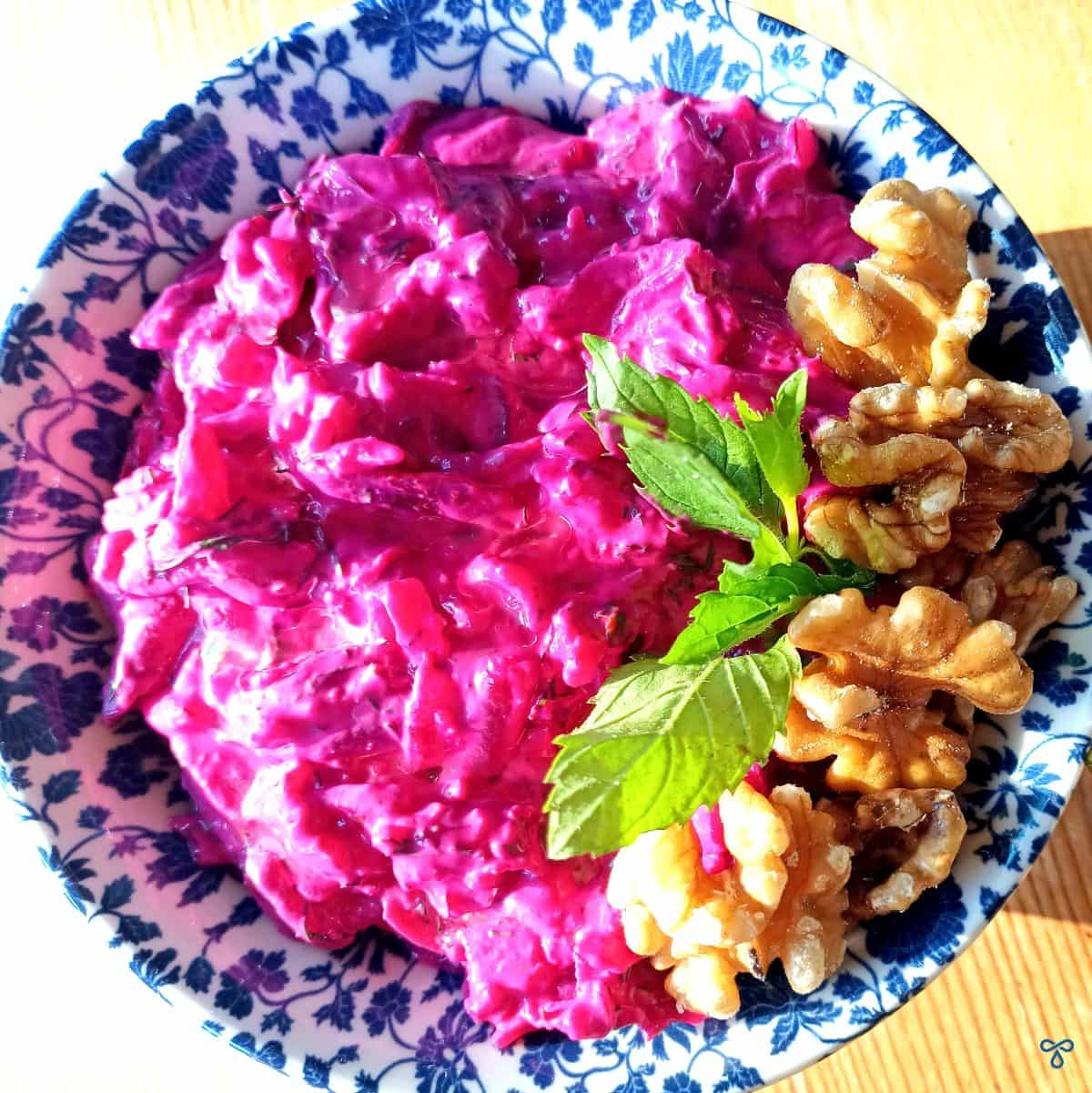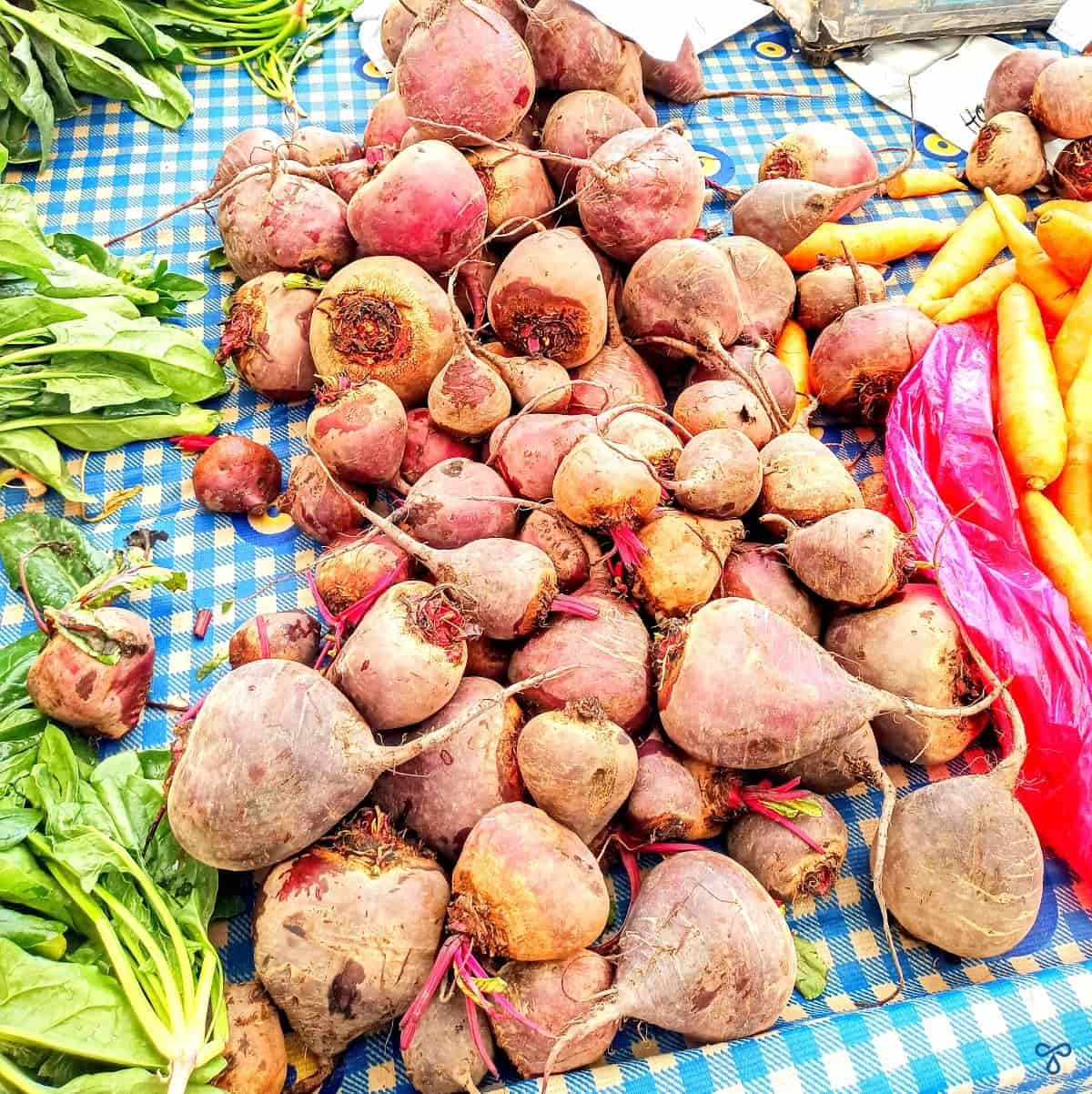Love beetroot? Whether yes or no, we’re sure this colourful Turkish beetroot and yoghurt dip recipe – pembe sultan – will tempt the taste buds!

Beetroot – or beets as they’re also known – have become a big part of our diet since living in Fethiye.
It’s not so much that they feature in lots of the famous dishes in Turkish cuisine. It’s more the fact that they’re an almost constant presence; both in our house and when we’re choosing meze dishes in restaurants.
Pancar turşusu (pickled beetroot) is a favourite, as is the meze we’re making in this recipe, today…
By Any Other Name
If you are tempted by the fabulously vibrant pink colour and you want to order this meze in a restaurant, it has various names that might appear on the menu:
- Pembe Sultan – Translating to ‘pink sultan,’ we love this name.
- Yoğurtlu Pancar Salatası – beetroot salad with yoghurt. We prefer to think of pembe sultan as more of a meze dip rather than a salad. Yoghurt salad just doesn’t sound right. And Turks use beetroot chunks in salads, anyway.
- Yoğurtlu Kırmızı Pancar Mezesi – Yoghurt and red beetroot meze. Yes, we can get with this one.
- Kırmızı Pancar Tarator – Beetroot in yoghurt sauce. You might recall one of our favourite Turkish recipes, havuç tarator – carrot and garlic yoghurt dip. Well, here we are with the beetroot and some slight differences to the recipe.
If you order any of those, you’re in for treat of colour that can be a part of your meze table. Or a great side dish.
You’re also in for a treat when it comes to flavour, too!
Whilst beetroot can sometimes have an overpowering earthy flavour, the combination of the yoghurt, fresh herbs, fresh garlic and fresh lemon juice – which is quickly absorbed by your grated beetroot – helps the sweetness of the beetroots to come through.
Trust us. Add some of your Turkish beetroot and yoghurt dip to a fresh-from-the-oven piece of balloon bread and you’re away!
So tasty!
Cooking The Beetroot
Always for sale on the local markets around these parts, at some times of year, you can get beetroots with their stalks and leaves still intact. Which is even better for other making other salads, too.

But our latest purchase was, as you can see, foliage-free.
And you can also see that the size of the beets varies wildly.
The Long Leisurely Way
If you’re using fresh beetroot, like this, try to get ones that are similar in size so that they’ll cook in the oven at the same time.
Just give them a wash and wrap them in individually in a sheet of foil. Then place them onto a baking sheet or tray.
Tip: Don’t remove the little bits of chopped stalk from the top before wrapping your beetroots. This will help to prevent them from bleeding too much.
Into the centre of the oven at 220 degrees Celsius (428 degrees Fahrenheit) until they’re softening. Then you can remove them and peel them.
The cooking time will depend on the size of the beetroot. But they take around the same amount of time as when you are baking jacket potatoes.
The Quick Way
Whilst we do buy – and bake – raw beetroot, we do also like to make life easier for ourselves on occasion.
Our local supermarket sells packs of peeled, whole, ready-cooked beetroot.
If you want to rustle up a quick and convenient Turkish beetroot and yoghurt dip, using ready-cooked beetroot is the way forward.
The Rest Of Our Turkish Beetroot & Yoghurt Dip Ingredients
- Süzme yoghurt: This is strained Turkish yoghurt – but natural Greek yoghurt is fine if you can’t get any süzme yoghurt. We’re looking for a creamy texture for our dip and a smooth, strained yoghurt is just the ticket.
- Garlic cloves: Whatever Turkish yoghurt dip we make, grated or chopped garlic always features. You can use the garlic to taste. We love the garlic flavour so tend to use more than one clove.
- Fresh lemon: The fresh lemon juice will start to gently pickle the beetroot and temper the earthy flavours.
- Fresh herbs: Two popularly used fresh herbs in Turkish cuisine; we’re using chopped dill and chopped mint. Both strong flavours and compliment each other well.
- Walnuts: Again, commonly used in Turkish salads and dips. They go really well in this yoghurt and beetroot dip. We like to break some up into really small pieces to mix into the dip as well as using them to garnish.
- Olive oil: Just to finish everything off. A good drizzle of olive oil over the top to serve.
Serve your pembe sultan alongside other meze dishes. Or have it as side to grilled meats like ızgara köfte or chicken shish.
And if you just want to celebrate this beetroot and yoghurt dip all on its own, some warm flatbreads are the perfect partner!
Our Turkish Beetroot & Yoghurt Dip Recipe – Pembe Sultan
Okay, let’s make pembe sultan…
Pembe Sultan – Turkish Beetroot & Yoghurt Dip
SaveSaved!
Print
Pin
Prevent your screen from going dark
-
1 large bowl
-
1 grater
-
1 sharp knife
- 200 grams beetroot (see notes below)
- 2 tablespoons natural yoghurt
- 2 cloves garlic (peeled & grated)
- 5 walnuts (smashed)
- 1 tablespoon fresh dill (finely chopped)
- 1 tablespoon fresh mint (finely chopped)
- ½ lemon (juice of)
- ½ teaspoon salt
To Garnish
- 5 walnuts (broken into chunks)
- 1 small sprig of fresh mint
- 2 teaspoons olive oil (drizzled over the top)
-
First of all, grate your cooked beetroot into your bowl and sprinkle with salt.
-
Now add your garlic and lemon juice and gently mix together.
-
Add your yoghurt and stir until everything is mixed. Your yoghurt will take on a vibrant magenta colour immediately.
-
Stir in your dill, mint and walnuts and do a taste test. Add more lemon juice or salt if necessary.
-
When yoıu are ready to serve, top your beetroot and yoghurt dip with the broken walnuts and sprig of mint and drizzle with your olive oil.
- As with all of our recipes, the nutrition calculations are meant as a general guide only and are calculated by a 3rd party API. Please do your own due diligence if you have an special dietary requirements.
- If you are using Greek yoghurt rather than Turkish süzme yoghurt, make sure it is unsweetened.
- In this recipe, for convenience, we usually use ready cooked and peeled beetroot.
- If you are cooking your beetroot from raw, wrap them in foil and bake them as you would a baked potato in the oven.
- Cooking time will vary depending on the size of the beetroot but you don’t need to be too careful about them being very soft. Once cool, you can peel and grate them.
- If we are peeling and grating beetroot that we have cooked ourselves, we use gloves to avoid staining our hands.
- For precooked beetroot, washing your hands straight after you have grated the beetroot is enough to remove the colour.
Serving: 1Calories: 85kcalCarbohydrates: 8gProtein: 2gFat: 6gSaturated Fat: 1gPolyunsaturated Fat: 3gMonounsaturated Fat: 2gCholesterol: 1mgSodium: 335mgPotassium: 233mgFiber: 2gSugar: 4gVitamin A: 92IUVitamin C: 11mgCalcium: 35mgIron: 1mg
You can find our pembe sultan recipe in the meze section of our Turkish recipes collection.
And if you love beetroot as much as we do, check out our pea and feta salad with chunks of beetroot.
Afiyet olsun!
